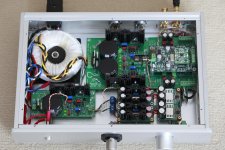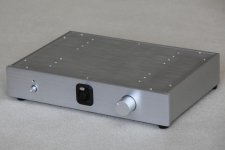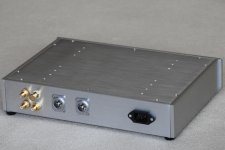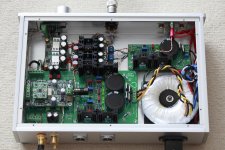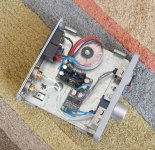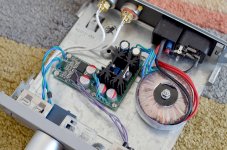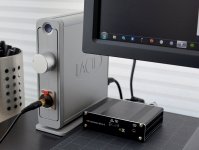I'll be offering bare PCBs, completely assembled PCBs, and likely a fully assembled product style version.
I knew it....

Any chance that you'll be able to butt up a ESS 9023 to the headphone amp input? As used in the ODAC.It's in the works right now. I will be offering all variants in a new layout that is designed to fit in an extruded chassis.
Cheers,
Owen
Any chance that you'll be able to butt up a ESS 9023 to the headphone amp input? As used in the ODAC.
Are you asking for a piggyback board along the lines of a Dragonfly or Meridian type dac as an add on?
Piggy back; no.
Same board; yes.
Minimum possible track length, DAC chip output pins as near as touching head phone amp input pins; yes.
Maybe the DAC chips 200 Ohm resistors can be missed out in this case?
Assuming the 9023 is good enough. I've not listened to one yet. I like the lack of any output chips and passives smearing the analogue sound.
Going by the measurements numbers here: http://nwavguy.blogspot.co.uk/2012/04/odac-released.html (scroll down a tiny bit to what might be page two, paragraph called The Real Numbers) the DAC1 is a lot better. Do those numbers mean much though compared to missing out everything between the DAC chip and the amp input?
Same board; yes.
Minimum possible track length, DAC chip output pins as near as touching head phone amp input pins; yes.
Maybe the DAC chips 200 Ohm resistors can be missed out in this case?
Assuming the 9023 is good enough. I've not listened to one yet. I like the lack of any output chips and passives smearing the analogue sound.
Going by the measurements numbers here: http://nwavguy.blogspot.co.uk/2012/04/odac-released.html (scroll down a tiny bit to what might be page two, paragraph called The Real Numbers) the DAC1 is a lot better. Do those numbers mean much though compared to missing out everything between the DAC chip and the amp input?
Last edited:
Piggy back; no.
Same board; yes.
Minimum possible track length, DAC chip output pins as near as touching head phone amp input pins; yes.
Maybe the DAC chips 200 Ohm resistors can be missed out in this case?
Assuming the 9023 is good enough. I've not listened to one yet. I like the lack of any output chips and passives smearing the analogue sound.
OK I get the idea now, and it is a good one. Not overly intimate with the 9023, but does it not have an onboard amp? Would feeding that amp into the wires cirucuits not cause havoc?
Piggy back; no.
Same board; yes.
Minimum possible track length, DAC chip output pins as near as touching head phone amp input pins; yes.
Maybe the DAC chips 200 Ohm resistors can be missed out in this case?
Assuming the 9023 is good enough. I've not listened to one yet. I like the lack of any output chips and passives smearing the analogue sound.
Going by the measurements numbers here: NwAvGuy: ODAC Released (scroll down a tiny bit to what might be page two, paragraph called The Real Numbers) the DAC1 is a lot better. Do those numbers mean much though compared to missing out everything between the DAC chip and the amp input?
Well in the original Wire spirit, perhaps a look at some instrumentation DAC's would be in order and a better fit. Although last I heard (and I do not follow that closely) they were only 20 bit.
And of course there is the WM8742 which has just about everything but the kitchen sink on board and supports 24/192 inherently
MLW168:
Great looking setup! Very clean wiring and a nice simple layout. I'm really glad you got everything up and running without any issues or damage.
Kuribo:
It should indeed work quite well for that application. It has no problems with low impedance loads, and it can source a whole lot of current for a headphone amp.
It might be worth doing a little further research into exactly what the drive requirements are for the headphones as any headphone spec given in watts is always a little suspicious since the load varies so greatly. If you need a lot of voltage swing, then the BAL-BAL version is definitely the best option, but if you need a lot of current, then all the amps are the same 250mA peak. The ideal load for maximum power delivery is roughly 64 ohms, which can draw 2 watts RMS. With the BAL-BAL version and a 130 ohm load you can deliver twice that power level, for roughly 4 watts.
I suggest getting the sensitivity spec on the headphones and working your way backwards from your maximum desired output SPL to see how much power you really need. I have heard some pretty obscene comments about power requirements for various low sensitivity headphones, but when you crunch the numbers, they often turn out to be a little inflated.
Ian:
I'm personally not all that keen on the 9023. If you're on a tight budget, or you like the simplicity of a single IC solution then it's probably a good choice, but it's not up to par with the 9012 or 9018. I even prefer some of the TI parts and one of the ADI parts to the 9023.
I'm not exactly targeting mediocrity with "The Wire" series. It's more of a "performance at any cost" approach. If the end product happens to be affordable, then it's purely by coincidence (or luck depending on how you look at it) For that reason, it's unlikely that you'll see a 9023 from me.
For that reason, it's unlikely that you'll see a 9023 from me.
There will be a 9012 solution coming, but it will be on its own, and probably not with a headphone amp built in, although it's something to consider. Right now I'm focused on the 9102 ADC, and once that's done, it'll be on to the DAC.
Cheers,
Owen
Great looking setup! Very clean wiring and a nice simple layout. I'm really glad you got everything up and running without any issues or damage.
I am wondering if this amp would work well driving a stax adapter and stax headphones? I am told the stax phones need about 3 watts or so....I think the imput impedence of the adapter is around 30 ohm....???
Kuribo:
It should indeed work quite well for that application. It has no problems with low impedance loads, and it can source a whole lot of current for a headphone amp.
It might be worth doing a little further research into exactly what the drive requirements are for the headphones as any headphone spec given in watts is always a little suspicious since the load varies so greatly. If you need a lot of voltage swing, then the BAL-BAL version is definitely the best option, but if you need a lot of current, then all the amps are the same 250mA peak. The ideal load for maximum power delivery is roughly 64 ohms, which can draw 2 watts RMS. With the BAL-BAL version and a 130 ohm load you can deliver twice that power level, for roughly 4 watts.
I suggest getting the sensitivity spec on the headphones and working your way backwards from your maximum desired output SPL to see how much power you really need. I have heard some pretty obscene comments about power requirements for various low sensitivity headphones, but when you crunch the numbers, they often turn out to be a little inflated.
Piggy back; no.
Same board; yes.
Minimum possible track length, DAC chip output pins as near as touching head phone amp input pins; yes.
Maybe the DAC chips 200 Ohm resistors can be missed out in this case?
Assuming the 9023 is good enough. I've not listened to one yet. I like the lack of any output chips and passives smearing the analogue sound.
Going by the measurements numbers here: NwAvGuy: ODAC Released (scroll down a tiny bit to what might be page two, paragraph called The Real Numbers) the DAC1 is a lot better. Do those numbers mean much though compared to missing out everything between the DAC chip and the amp input?
Ian:
I'm personally not all that keen on the 9023. If you're on a tight budget, or you like the simplicity of a single IC solution then it's probably a good choice, but it's not up to par with the 9012 or 9018. I even prefer some of the TI parts and one of the ADI parts to the 9023.
I'm not exactly targeting mediocrity with "The Wire" series. It's more of a "performance at any cost" approach. If the end product happens to be affordable, then it's purely by coincidence (or luck depending on how you look at it)
There will be a 9012 solution coming, but it will be on its own, and probably not with a headphone amp built in, although it's something to consider. Right now I'm focused on the 9102 ADC, and once that's done, it'll be on to the DAC.
Cheers,
Owen
Owen, hes looking to drive the Stax adapter, not the headphones, the headphones need 600V swing or more, it will in effect be driving the transformer in the adapter, the load of the headphones themselves is mostly capacitive. the transformer primary load is very low due to the massive voltage amplification step up
the STAX adapters are to allow using speaker amps to drive the headphones and avoid the expense of a purpose built Electrostatic amp
the STAX adapters are to allow using speaker amps to drive the headphones and avoid the expense of a purpose built Electrostatic amp
Very glad to hear thata "performance at any cost" approach.
Thanks for sharing your experience of those DACs
Cheers,
Ian
Thanks Owen!
Here are a few photos of the finished product as promised. Due to the lack of skill, patience and chassis space, the wiring is a bit messy and the metal work left much to be desired as well.
The WIRE may not be quite break-in yet, I only have maybe 30 some hours of playing time on it. But one thing I can confirm now, which I noticed within the first song I played through the WIRE, is that this amp does bass like no other headphone amp I've heard, it's deep and well controlled. The WIRE gives the HD650 bass extension that I did not know it possesses. The WIRE also appears to be extremely revealing - I hear nuances in the music that I did not notice previously.
Thanks again for your help! Without you, gusp and DIYAUDIO this amp would not have been possible!
Here are a few photos of the finished product as promised. Due to the lack of skill, patience and chassis space, the wiring is a bit messy and the metal work left much to be desired as well.
The WIRE may not be quite break-in yet, I only have maybe 30 some hours of playing time on it. But one thing I can confirm now, which I noticed within the first song I played through the WIRE, is that this amp does bass like no other headphone amp I've heard, it's deep and well controlled. The WIRE gives the HD650 bass extension that I did not know it possesses. The WIRE also appears to be extremely revealing - I hear nuances in the music that I did not notice previously.
Thanks again for your help! Without you, gusp and DIYAUDIO this amp would not have been possible!
Attachments
Very nice! I've struggled with casework/wiring myself - though I strive to improve it each project I take on. Overall, given the space constraints you have - I think you've done a good job (from one rookie to another  .
.
I've been working on my own casing for wire that rolls up my BIII, NTD1 IV and FIFO. I'm getting closer. I'm looking for 1/2 transformers that'll replace all these separates. Then, I'm putting together a UF.L/Otto II wiring harness that'll replace the current digital domain wiring. The NTD1 is known for throwing off serious heat, and this case design has finally put that issue to rest.

I've been working on my own casing for wire that rolls up my BIII, NTD1 IV and FIFO. I'm getting closer. I'm looking for 1/2 transformers that'll replace all these separates. Then, I'm putting together a UF.L/Otto II wiring harness that'll replace the current digital domain wiring. The NTD1 is known for throwing off serious heat, and this case design has finally put that issue to rest.

Finally got around to finishing this up. Thanks to Owen and everyone here for making this possible.
Housed in a re-purposed Lacie hard drive case. Plan on removing the Lacie logo, repainting and wiring an LED.
Housed in a re-purposed Lacie hard drive case. Plan on removing the Lacie logo, repainting and wiring an LED.
Attachments
What is the output power of this amp into say, 8 ohms?
Kuribo,
I answered most of your questions here:
http://www.diyaudio.com/forums/head...headphone-amplifier-pcbs-179.html#post3367649
The current limit is 250mA peak for all the amplifiers and the voltage swing is 16V peak for the SE and about 28V peak for the BAL-BAL.
Regards,
Owen
so about 7 watts for the bal bal version?
Yes, I would like to use it with electrostatics and an adapter (step up transformer) as mentioned.
I am told the adapter has a nominal impedance of 8 ohms and that the headphones need at least 4-5 watts power through it to work well....
Yes, I would like to use it with electrostatics and an adapter (step up transformer) as mentioned.
I am told the adapter has a nominal impedance of 8 ohms and that the headphones need at least 4-5 watts power through it to work well....
Last edited:
Hi Co60:
Nice work and creative. It looks great!
Hi MisterRogers:
That's quite a project you got going there! Great work! Hope you find the transformer that meets your needs.
The chassis I use was bought from China - the shipping costs nearly as much as the chassis itself. All I had to do was drilling the holes for the Neutrik connectors and top plate ventilation.
I originally used Mogami shielded balance cable between the IVY and the WIRE but it was too bulky for the space I have to work with. I ended up replacing them with braided Cat 6 wires hoping the balanced topology of the set up would be more tolerant. We'll see if interference becomes a problem. So far it seems to be working fine.
Interestingly, the whole set up sounds different after I put it in the chassis. I don't think the wiring change or break-in explains it. Very curious!
Nice work and creative. It looks great!
Hi MisterRogers:
That's quite a project you got going there! Great work! Hope you find the transformer that meets your needs.
The chassis I use was bought from China - the shipping costs nearly as much as the chassis itself. All I had to do was drilling the holes for the Neutrik connectors and top plate ventilation.
I originally used Mogami shielded balance cable between the IVY and the WIRE but it was too bulky for the space I have to work with. I ended up replacing them with braided Cat 6 wires hoping the balanced topology of the set up would be more tolerant. We'll see if interference becomes a problem. So far it seems to be working fine.
Interestingly, the whole set up sounds different after I put it in the chassis. I don't think the wiring change or break-in explains it. Very curious!
Yes...
It's in the works right now. I will be offering all variants in a new layout that is designed to fit in an extruded chassis.
I'll be offering bare PCBs, completely assembled PCBs, and likely a fully assembled product style version.
Stay tuned here for a link in the coming weeks.
Cheers,
Owen
Been several weeks-any updates???
- Home
- Amplifiers
- Headphone Systems
- "The Wire" Ultra-High Performance Headphone Amplifier - PCB's
